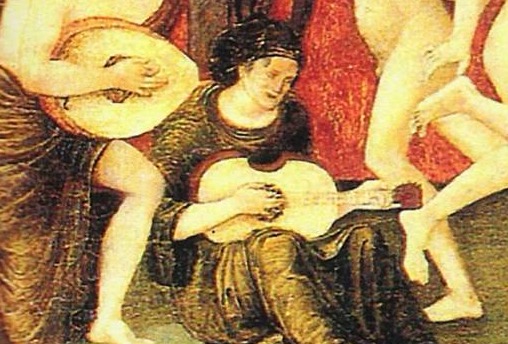Viola da mano accompanying dancers.
(1490-1500) - Muzeul National de Arta, Bucharest,
instrument: viola da mano (vihuela) | century: 15cent/3/late | catalogue nº: 15-365

Artwork
Creator Cavalletto, Giovanni Battista
Medium Artwork: Painting
Location
City Ferrara | Region Italy | Old kingdom Ferrara
Characteristics
| Body Corners | Strings strings | Neck Short | Pegbox Unclear |
| Bridge Not visible | Frets Unclear | Back Flat | Pegs Unclear |
| Technique Plucked fingers thumb in |
Commentary
ARTWORK
Painting attributed to Giovanni Battista Cavalletto, Bologna, Italy, 1490-1500. Tempera on wood, 42.3 x 62.5 cm
Muzeul National de Arta, Bucharest, inv. 7990/24. The musicians are placed at the bottom left of the painting, dressed in garb all’antica, with a lutenist and viola da mano player accompanying a group of naked dancers (an allusion to Antiquity) performing a tarantella. There has been some dispute as to who painted the original; Cavichi indicates that it was first attributed to Luca Signorelli (Bechelin 1898), and then to Giovanni Francesco Maineri (Zamboni 1975, 43–44), but more recently to Giovanni Battista Cavalletto (Bauer-Eberhardt 1999, Medica 2008a and 2008b), an artist from Bologna—specialised in miniatures—who also worked in Ferrara, Mantua and Rome. Thanks to Camilla Cavichi for providing the image and general assistance.
INSTRUMENT
An viola da mano with cornered waists and, almost certainly, a flat back. The bridge is not visible and there is a circular rosette in the centre of the soundboard. It has a short neck ending in what appears to be a scroll pegbox but cannot be clearly discerned from the available images. Similarly the number of strings cannot be determined. It is one of a number of Italian representations in which a viola da mano is playing together with a lute.